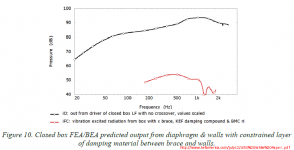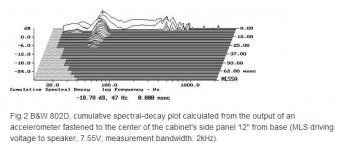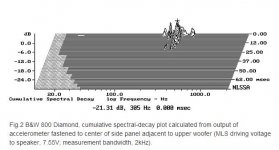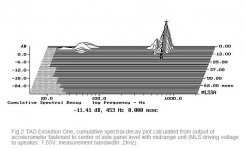Re; the "Q" of resonances. Many people instinctively assume that high Q must be worse than a more damped low Q. But this is not necessarily the case. What Barlow (Leak, sandwich cone fame) found many yrs ago was that when a resonance is damped (the peak lower but MUCH broader) it can then be excited by a much larger range of frequencies and was MORE audible as a consequence. All shown in his JAES (or Wireless World) paper from about 40yrs ago.
So the published work supports Dave's contention.
The best work I've seen tries to minimize decay time as that is what the ear responds to most sensitively.
Toole's Sound Reproduction shows other experiments that also support greater audibility of low Q resonances.
dave
Re; #18.
Now, allowing for the fact that our hearing is subjective then no one could argue with you. Some people may well prefer one type of colouration over another. I try and avoid the subjective/objective debate but the point here is that the research refers to the audibility (not preference) of the colourations and by that criteria there is no debate........Dave is right.
I will try and find the papers. (There are more than one, not just Barlow's) and they do a number of frequencies at a number of different levels and the results are pretty clear.
Anyway going back to original post the concern expressed was "how much sound comes out of the cabinet".....
(1) There are ways of minimizing cabinet output.......and that given that someone once described a speaker box "as a collection of more or less well damped resonances"..
(2) people will express a preference for their favourite colouration....
JB
Now, allowing for the fact that our hearing is subjective then no one could argue with you. Some people may well prefer one type of colouration over another. I try and avoid the subjective/objective debate but the point here is that the research refers to the audibility (not preference) of the colourations and by that criteria there is no debate........Dave is right.
I will try and find the papers. (There are more than one, not just Barlow's) and they do a number of frequencies at a number of different levels and the results are pretty clear.
Anyway going back to original post the concern expressed was "how much sound comes out of the cabinet".....
(1) There are ways of minimizing cabinet output.......and that given that someone once described a speaker box "as a collection of more or less well damped resonances"..
(2) people will express a preference for their favourite colouration....
JB
Perhaps the kids wrapping their monster "head-ache" boxes with carpeting were onto something, for the wrong reasons? How about acoustic tiling...A generous radius for edge diffraction, all the way around & the back.
Now, what about the porous nature of acoustic materials serving as the edge radius?
__________________________________________________Rick.........
Now, what about the porous nature of acoustic materials serving as the edge radius?
__________________________________________________Rick.........
Think also of the room itself : it is supposed to be solid and stiff, yes, it's a home!
But if I put music playing very loud- that means also a 5" powered by 5W or a 8" powered by a 3 W amp !-talking about subwoofers...imagine two 8" powered by....30 W !!!!
and if I go, say, to the bathroom aside : the window rattles and so the walls are moving!
No way of stopping this. Now apply that to a speaker box.
But if I put music playing very loud- that means also a 5" powered by 5W or a 8" powered by a 3 W amp !-talking about subwoofers...imagine two 8" powered by....30 W !!!!
and if I go, say, to the bathroom aside : the window rattles and so the walls are moving!
No way of stopping this. Now apply that to a speaker box.
Panel (enclosure) vibrations are studied with laser doppler vibrometers nowdays. They usually make a map of surfaces showing resonant frequencies. Similar method is also used by luthiers and other music instrument research or engineering studies. Guitar (contact) microphones and motion sensors are not so accurate.
Laser vibrometry is also used to study the behaviour of cone and spider membranes.
Big speaker companies like KEF and Wilson Audio have studied this much. KEF LS50 whitepaper tells pretty much of the construction of multilayer cabinets.
Nanometers - YouTube
But it is still obscure to me how loud these panels vibrate/ring. Stereophile shows panel vibrations too, but from a single point and dB scale is irrelevant (measuring distance not said).
This is from the KEF whitepaper, a simulation/modelling of driver vs. panel soud pressure level
Laser vibrometry is also used to study the behaviour of cone and spider membranes.
Big speaker companies like KEF and Wilson Audio have studied this much. KEF LS50 whitepaper tells pretty much of the construction of multilayer cabinets.
Nanometers - YouTube
But it is still obscure to me how loud these panels vibrate/ring. Stereophile shows panel vibrations too, but from a single point and dB scale is irrelevant (measuring distance not said).
This is from the KEF whitepaper, a simulation/modelling of driver vs. panel soud pressure level
Attachments
Last edited:
If you want to follow it from the point of view of the "source" then there is a paper from Pioneer by Andrew Jones. I recall and that was good on the effects of either flexible or rigid mounting of drivers and the change that made to both objective measurements of the panels and the preferences of a listening panel.
And if you can't find it the results in both cases was a preference for flexible mounting.
JB
And if you can't find it the results in both cases was a preference for flexible mounting.
JB
Last edited:
Think also of the room itself : it is supposed to be solid and stiff, yes, it's a home!
But if I put music playing very loud- that means also a 5" powered by 5W or a 8" powered by a 3 W amp !-talking about subwoofers...imagine two 8" powered by....30 W !!!!
and if I go, say, to the bathroom aside : the window rattles and so the walls are moving!
No way of stopping this. Now apply that to a speaker box.
Reminds me....the first time I've heard a test tone CD...
My shopmate at the local Honda Dealership.....He moonlighted as a DJ, he wondered if I might take a look at his "Road going" speakers.....Poor things were beat to crap, 15" PA type, a 2X7 horn & some cheapo Motorola crystal (3). The things had been bashed on unprotected corners, big grind marks..you could see the plywood delaminating.
Well, we both decided to re-build the pair.
I think it wound up with the existing horn, I had him get the RS mid-range horn, so, 15", horn, horn
Well trouble was I recommended one inch MDF &"make it a little bigger".
Stood about chin high.....
He had a test cd........We put the old one side by side to the new one ....A 32 Hz tone on the old one set to buzzing & wheezing from structural failure. Over to other-one What is that rattle..........do I have this thing on?.....the adjacent room was rattling its windows...hadn't registered the F yet.....Wow, what a difference...... He d-jayed for our wedding.
_______________________________________________Rick..........
Last edited:
Earlier some old BBC papers were cited but these were many decades ago. We should not be referring to such old papers to draw conclusions. What about some newer papers? The BBC are hardly the epitome of hi fidelity audiophile quality.
I quoted those because they had done the research. A lot of the speakers which were available commercially didn't apply the findings very well (often using thicker wall cabinets with damping instead of the thin wall specified).
The physic of the basic research hasn't changed. It is also instructive to read the papers and note that they are designed for specific applications.
Finally, don't forget that the BBC were using live music as the reference. Current designs which stick to their approach (Harbeth and Stirling Broadcast, for example) continue to get good reviews.
Stirling Broadcast LS3/6 | The Absolute Sound
As for the dismissive remark about the Beeb not being the epitome, etc., at one time they maintained their own research facility for exactly this type of research, with an anechoic chamber hired by mainstream manufacturers. Rather than indulge in audiophile myth, they continue to do a lot of the cutting edge research which is picked up by the audio companies years later. Have a prowl of their research blogs before dismissing them so casually:
http://www.bbc.co.uk/rd/projects
Last edited:
KEF link corrected!
Interesting paper. Clearly damping rules. Stiffening doesn't solve the problem, but damping does. I do all the things that they mention in the paper and have for more than a decade.
hI Omholt,
Is it true that good designers try to put the resonance of the bass cabinet the nearer in a dip of ohm or fhz curve, sometimes in the Xo intersection of the bass/medium xo.
By the way, the speakers maid with metal sound bad. How to understand the damping level and resonance in the sound signature of a speaker ?
Some people use light wood of 19 mm to klimb the resonance, others like dynaudio try a solid baffle decoupled with elastic glue from the cabinet...
do we hear bass distorsion a lot (< 300 hz). Maybe i'm Off topic, but what is the problem : the singing of the cabinet or the vibration of the bass for mid and tweeter ? I just want to understand if i have to make my next push pull OB skelrton bass cabinet with steel tube or just with wood à la Linkwitz...with another mid/tweeter cabinet ?
i like the design of the kef 104/2 : independant solid apolito cabinet tied to a vertical push/pull cabinet. Is it important as all my wood furnitures and light wood doors vibrate with the sound of the speaker in the room ?
Is it true that good designers try to put the resonance of the bass cabinet the nearer in a dip of ohm or fhz curve, sometimes in the Xo intersection of the bass/medium xo.
By the way, the speakers maid with metal sound bad. How to understand the damping level and resonance in the sound signature of a speaker ?
Some people use light wood of 19 mm to klimb the resonance, others like dynaudio try a solid baffle decoupled with elastic glue from the cabinet...
do we hear bass distorsion a lot (< 300 hz). Maybe i'm Off topic, but what is the problem : the singing of the cabinet or the vibration of the bass for mid and tweeter ? I just want to understand if i have to make my next push pull OB skelrton bass cabinet with steel tube or just with wood à la Linkwitz...with another mid/tweeter cabinet ?
i like the design of the kef 104/2 : independant solid apolito cabinet tied to a vertical push/pull cabinet. Is it important as all my wood furnitures and light wood doors vibrate with the sound of the speaker in the room ?
Last edited:
That statement ignores the fact that the energy available to excite the panel resonance is inversly proportianal to the square of the frequency
A high Q resonance also requires a large number/amount of input over a limited bandwidth to excite it, not something often seen in music.
So if you can make the panel ring at high frequency, and high Q, the liklihood of it ever getting excited by music becomes VERY low.
dave
If true, wouldn't these arguments be valid for the driver membrane itself too? But we now that high frequency resonances in driver membranes can be excited by audio signals, don't we?
Dave - could you support your first statement. I am not sure that I agree with it.
Dave is usually ignoring a few things in this topic.
Of course, the driver's kinetic energy falls off with 1/f², and that energy is driving the panel resonances. But this says nothing about the amount of energy which gets transmitted to the cabinet (which depends on the mechanical impedance), and from the cabinet to air (radiation impedance).
Looking at the BBC measurements and others it becomes clear that the high frequency resonances are equal in magnitude and relative bandwidth to the low frequency resonances, and that the high frequency resonances are more likely to be audible than the low frequency resonances.
The conclusion is that the best cabinet has high damping, high mass and low stiffness. This keeps the resonances low in frequency and magnitude, and are therefore not audible any more. BTW, BBC/Harwood praises the benefits of (reinforced) plastic materials, but they decided to use thin plywood with thick damping for economic reasons instead.
Re; the "Q" of resonances. Many people instinctively assume that high Q must be worse than a more damped low Q. But this is not necessarily the case. What Barlow (Leak, sandwich cone fame) found many yrs ago was that when a resonance is damped (the peak lower but MUCH broader) it can then be excited by a much larger range of frequencies and was MORE audible as a consequence. All shown in his JAES (or Wireless World) paper from about 40yrs ago.
So the published work supports Dave's contention.
The best work I've seen tries to minimize decay time as that is what the ear responds to most sensitively.
Cheers, Jonathan
I like the Barlow paper but it is misapplied whenever referenced in cabinet discussions. He and others looked at a situation with electrical filters in parallel with a flat straight through chain. He found that raising Q made a resonance less audible. Specifically, if Q was doubled the resonance would need to go up 3dB for similar audibility.
This implies that if we had a fixed peak height that higher Q will be less audible than lower Q. Trouble is, with mechanical resonance and assuming that damping is being varied, peak height goes up 6dB when Q is doubled. So the 6dB level gain is twice the perceptual loss. Cabinet resonances are, in net, 3dB more audible when Q is doubled.
David
Last edited:
I quoted those because they had done the research. A lot of the speakers which were available commercially didn't apply the findings very well (often using thicker wall cabinets with damping instead of the thin wall specified).
The physic of the basic research hasn't changed. It is also instructive to read the papers and note that they are designed for specific applications.
As for the dismissive remark about the Beeb not being the epitome, etc., at one time they maintained their own research facility for exactly this type of research, with an anechoic chamber hired by mainstream manufacturers. Rather than indulge in audiophile myth, they continue to do a lot of the cutting edge research which is picked up by the audio companies years later. Have a prowl of their research blogs before dismissing them so casually:
Here, here!
- Status
- This old topic is closed. If you want to reopen this topic, contact a moderator using the "Report Post" button.
- Home
- Loudspeakers
- Multi-Way
- how much cabinet sound



